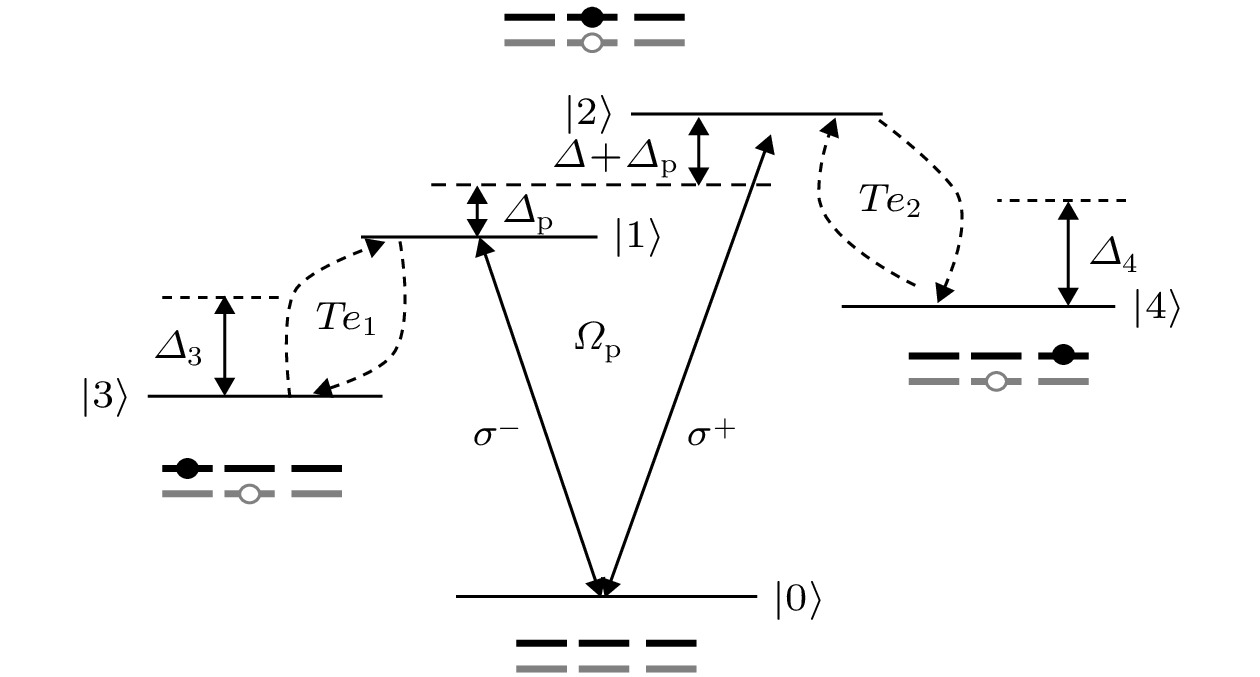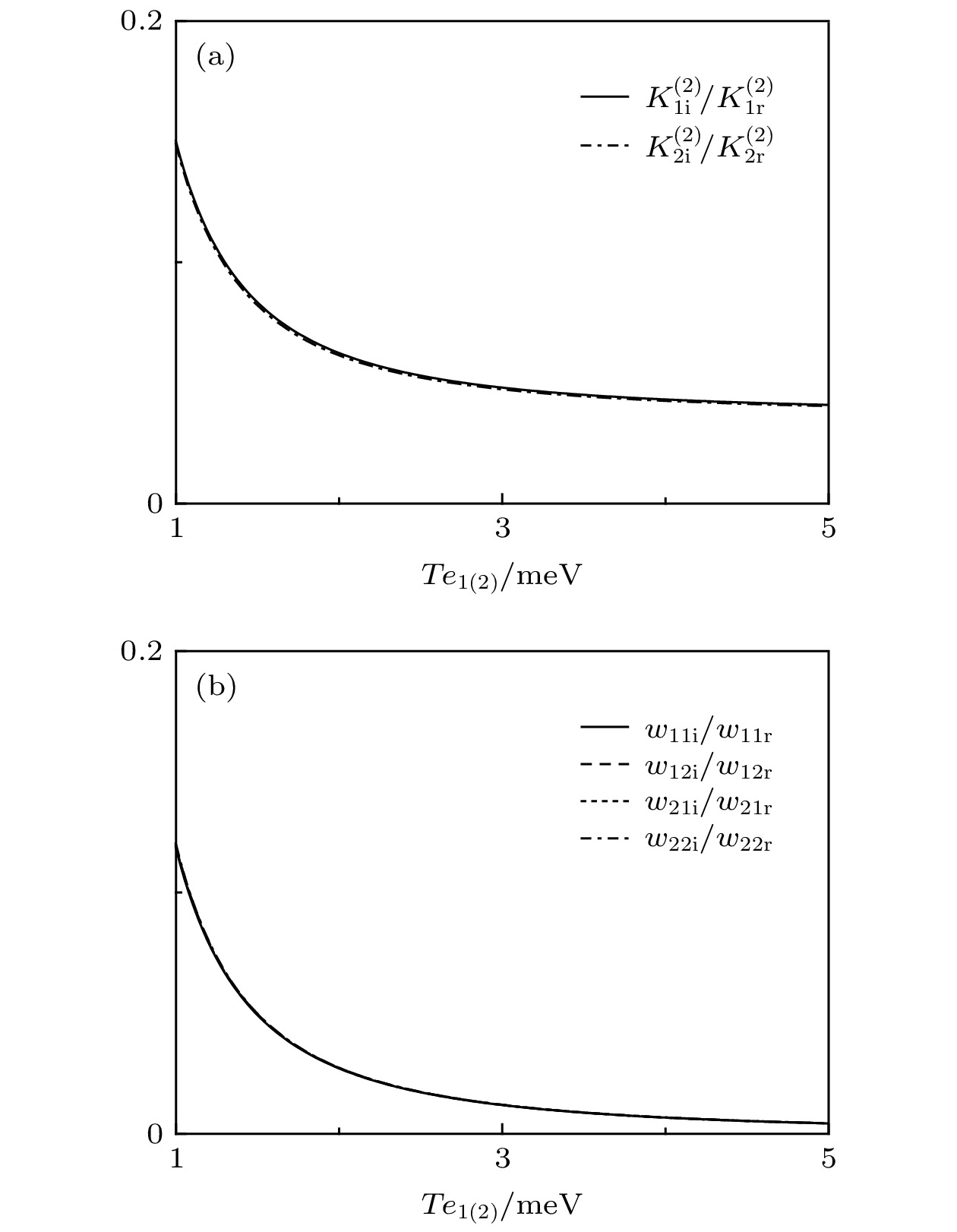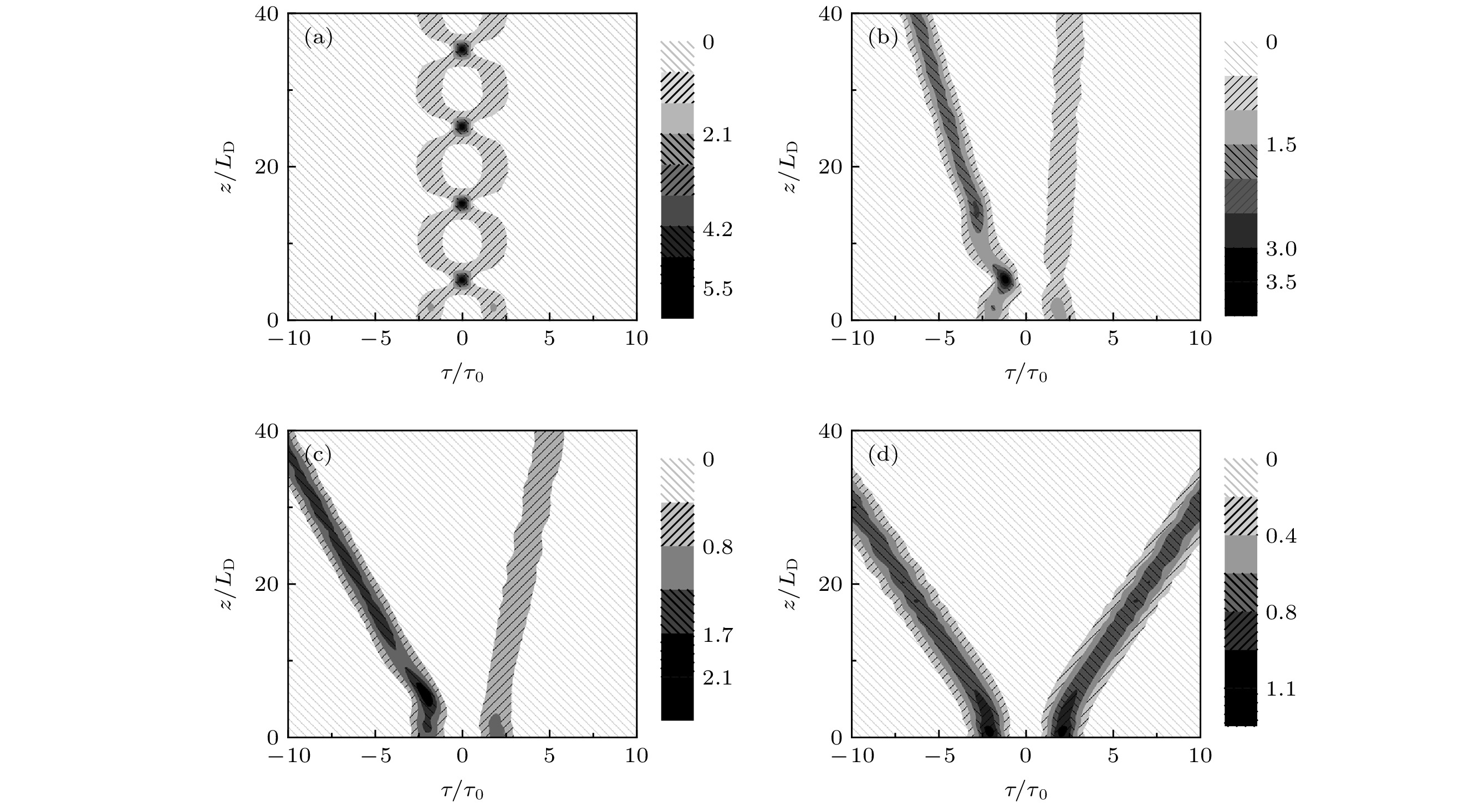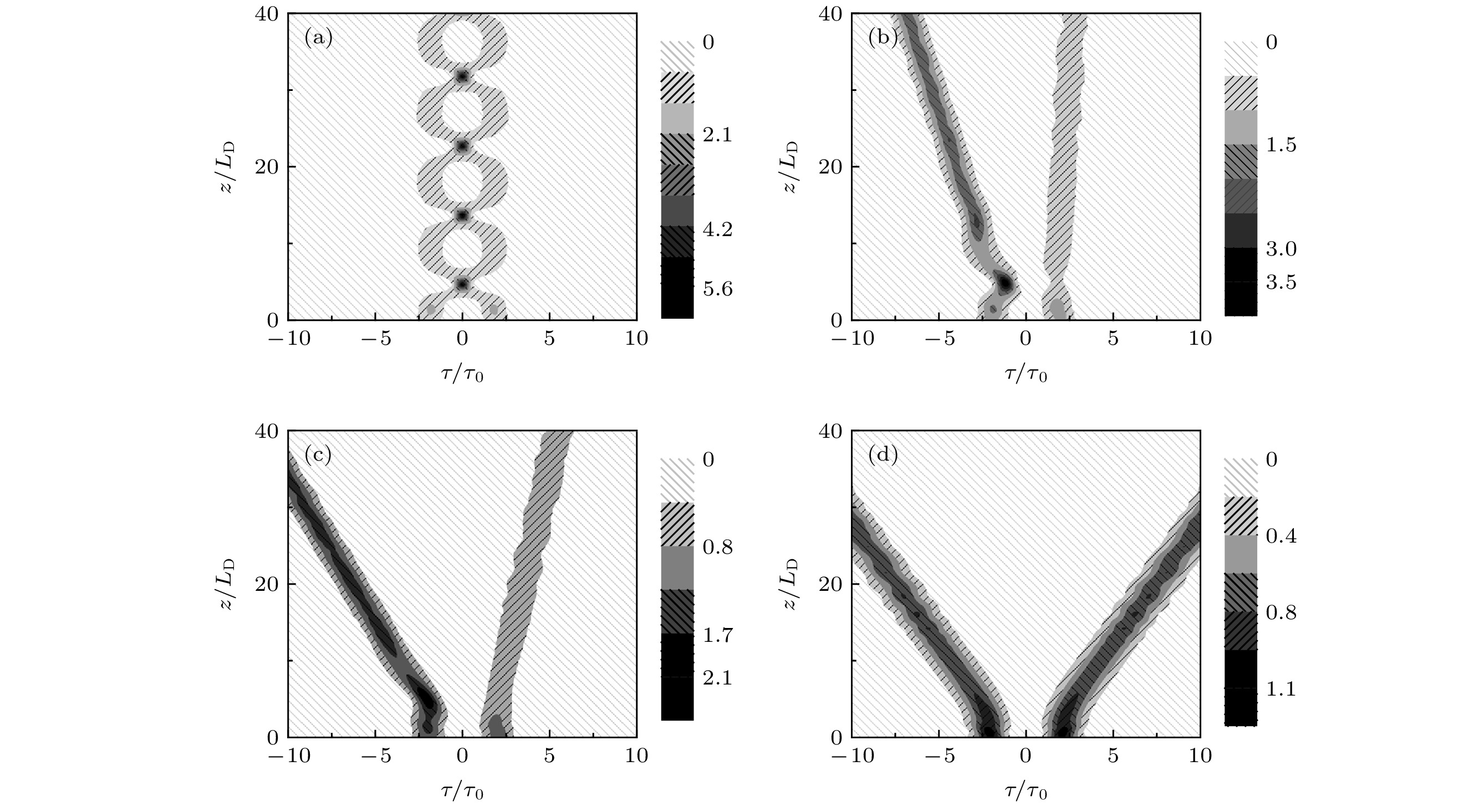-
Experimentally, the triple-quantum-dots system can be produced on a GaAs $ \left[ {001} \right]$ substrate by molecular beam epitaxy or in-situ atomic layer precise etching, thus enabling a triangle triple quantum dot (QD) aligned along the$ \left[ {1\bar 10} \right]$ direction. According to this, we first propose a five-level M-type triple QD electromagnetically induced transparency (EIT) model which consists of a triple QD molecule interacting with a weakly linearly polarized probe field with two orthogonal polarization components under the action of a magnetic field parallel to the light propagation direction. Subsequently, by using the multiple-scale method combined with the Fourier integration method, the propagation characteristics of the optical solitons and the collision characteristics of two solitons in the system are studied. It is shown that the optical solitons can form and propagate stably in this system under the action of quantum inter-dot tunneling coupling whose formation mechanism is different from the soliton-forming mechanism in ultra-cold atomic, single QD, and double QD EIT system. This is because the necessary condition for forming a soliton is to use a strong light beam to modulate a weak light beam, whether it is in an ultra-cold atom system, or a single quantum dot EIT medium or a double quantum dot EIT medium. In a word, the formation of soliton in previous EIT systems needs an additional strong controlling field, while the five-level M-type triple QD EIT system is dependent on the inter-dot tunneling.Since the solitons can propagate stably, the collision properties of the solitons may be studied in this system. Finally, by applying Fourier integration method, it is found that the collision behaviors of two solitons are determined by their initial phase difference. When their initial phase difference is 0, the collision behavior between the solitons is periodic elastic collision. While their initial phase difference is separately $ {\rm{\pi }}/4$ ,$ \text{π}/2$ , and$ \text{π}$ , the collision behaviors exhibit separation phenomenon due to repulsive effect. Interestingly, the collision characteristics of two solitons are controlled by the inter-dot tunneling strength. With the increase of inter-dot tunneling strength, the collision period of two solitons with the initial phase difference of 0 decreases, and the repulsive force of two solitons with the initial phase difference being separately π/4, π/2 and π increases. This provides some theoretical basis for experimentally controlling the soliton dynamical properties in semiconductor quantum dot devices.-
Keywords:
- inter-dot tunneling coupling /
- solition collision behaviors /
- phase difference /
- electromagnetically induced transparency medium
[1] Scott A C, Chu F Y F, McLaughlin D W 1973 P IEEE 61 1443
 Google Scholar
Google Scholar
[2] Dudley J M, Taylor J R 2009 Nat. Photonics 3 85
 Google Scholar
Google Scholar
[3] Song W W, Li Q Y, Li Z D, Fu G S 2010 Chin. Phys. B 19 070503
 Google Scholar
Google Scholar
[4] Wang Q, Wen L, Li Z D 2012 Chin. Phys. B 21 080501
 Google Scholar
Google Scholar
[5] Li Z D, Wang Y Y, He P B 2019 Chin. Phys. B 28 010504
 Google Scholar
Google Scholar
[6] Mollenauer L F, Stolen R H, Gordon J P 1980 Phys. Rev. Lett. 45 1095
 Google Scholar
Google Scholar
[7] Haus H A, Wong W S 1996 Rev. Mod. Phys. 68 423
 Google Scholar
Google Scholar
[8] Essiambre R J, Agrawal G P 1996 Opt. Lett. 21 116
 Google Scholar
Google Scholar
[9] Xie C, Karlsson M, Andrekson P A, Sunnerud H, Li J 2002 IEEE J. Sel. Top. Quantum Electron. 8 575
 Google Scholar
Google Scholar
[10] Badraoui N, Berceli T, Singh S 2017 19th International Conference on Transparent Optical Networks (ICTON) Girona, Spain, July 2–6, 2017 p1
[11] Li Z D, He P B, Li L, Liang J Q, Liu W M 2005 Phys. Rev. A 71 053611
 Google Scholar
Google Scholar
[12] Li L, Li Z D, Malomed B A, Mihalache D, Liu W M 2005 Phys. Rev. A 72 033611
 Google Scholar
Google Scholar
[13] Zhang X F, Yang Q, Zhang J F, Chen X Z, Liu W M 2008 Phys. Rev. A 77 023613
 Google Scholar
Google Scholar
[14] Zhang X F, Zhang P, He W Q, Lin X X 2011 Chin. Phys. B 20 020307
 Google Scholar
Google Scholar
[15] Yao S F, Li Q Y, Li Z D 2011 Chin. Phys. B 20 110307
 Google Scholar
Google Scholar
[16] Harris S E, Field J E, Imamoğlu A 1990 Phys. Rev. Lett. 64 1107
 Google Scholar
Google Scholar
[17] Harris S E 1997 Phys. Today 50 36
 Google Scholar
Google Scholar
[18] Kang H, Zhu Y 2003 Phys. Rev. Lett. 91 093601
 Google Scholar
Google Scholar
[19] Kasapi A, Jain M, Yin G Y 1995 Phys. Rev. Lett. 74 2447
 Google Scholar
Google Scholar
[20] Hau L V, Harris S E, Zachary D, Cyrus H B 1999 Nature 397 594
 Google Scholar
Google Scholar
[21] 唐宏, 王登龙, 张蔚曦, 丁建文, 肖思国 2017 物理学报 66 034202
 Google Scholar
Google Scholar
Tang H, Wang D L, Zhang W X, Ding J W, Xiao S G 2017 Acta. Phys. Sin. 66 034202
 Google Scholar
Google Scholar
[22] Wu Y, Deng L 2004 Opt. Lett. 29 2064
 Google Scholar
Google Scholar
[23] Wu Y, Deng L 2004 Phys. Rev. Lett. 93 143904
 Google Scholar
Google Scholar
[24] Huang G X, Hang C, Deng L 2008 Phys. Rev. A 77 011803
 Google Scholar
Google Scholar
[25] Kumar V R, Radha R, Wadati M 2008 Phys. Rev. A 78 041803
 Google Scholar
Google Scholar
[26] Chen Y, Bai Z, Huang G X 2014 Phys. Rev. A 89 023835
 Google Scholar
Google Scholar
[27] Gammon D, Snow E S, Shanabrook B V, Katzer D S, Park D, 1996 Science 273 87
 Google Scholar
Google Scholar
[28] Borr P, Langbein W, Schneider S, Woggon U, Sellin R L, Ouyang D, Bimberg D 2001 Phys. Rev. Lett. 87 157401
 Google Scholar
Google Scholar
[29] Guo R H, Shi H Y, Sun X D 2005 Photonics Asia 2004; Optoelectronics, Microelectronics, and Nanotech Beijing, China, November 8–11, 2004 p313
[30] Borges H S, Sanz L, Villas-Bôas J M, Alcalde A M 2010 Phys. Rev. B 81 075322
 Google Scholar
Google Scholar
[31] Högele A, Seidl S, Kroner M, Karrai K, Warburton R J, Gerardot B D, Petroff P M 2004 Phys. Rev. Lett. 93 217401
 Google Scholar
Google Scholar
[32] Yang W X, Chen A X, Lee R K, Wu Y 2011 Phys. Rev. A 84 013835
 Google Scholar
Google Scholar
[33] Kuo D M T, Guo G Y, Chang Y C 2001 Appl. Phys. Lett. 79 3851
 Google Scholar
Google Scholar
[34] Kouklin N, Menon L, Bandyopadhyay S 2002 Appl. Phys. Lett. 80 1649
 Google Scholar
Google Scholar
[35] Borges H S, Sanz L, Villas-Bôas J M, Diniz Neto O O, Alcalde A M 2012 Phys. Rev. B 85 115425
 Google Scholar
Google Scholar
[36] Yuan C H, Zhu K D 2006 Appl. Phys. Lett. 89 052115
 Google Scholar
Google Scholar
[37] She Y C, Zheng X J, Wang D L, Zhang W X 2013 Opt. Express 21 17392
 Google Scholar
Google Scholar
[38] Tian S C, Wan R G, Tong C Z, Fu X H, Cao J S, Ning Y Q 2015 Laser Phys. Lett. 12 125203
 Google Scholar
Google Scholar
[39] Wang J Y, Huang S, Huang G Y, Pan D, Zhao J, Xu H Q 2017 Nano Lett. 17 4158
 Google Scholar
Google Scholar
[40] Grove-Rasmussen K, Jørgensen H I, Hayashi T, Lindelof P E, Fujisawa T 2008 Nano Lett. 8 1055
 Google Scholar
Google Scholar
[41] Saraga D S, Loss D 2003 Phys. Rev. Lett. 90 166803
 Google Scholar
Google Scholar
[42] Fafard S, Spanner M, McCaffrey J P, Wasilewski Z R 2000 Appl. Phys. Lett. 76 2268
 Google Scholar
Google Scholar
[43] Beirne G J, Hermannstädter C, Wang L, Rastelli A, Schmidt O G, Michler P 2006 Phys. Rev. Lett. 96 137401
 Google Scholar
Google Scholar
[44] Krause B, Metzger T H, Rastelli A, Songmuang R, Kiravittaya S, Schmidt O G 2005 Phys. Rev. B 72 085339
 Google Scholar
Google Scholar
[45] Hang C, Huang G X 2008 Phys. Rev. A 77 033830
 Google Scholar
Google Scholar
[46] 佘艳超, 张蔚曦, 王登龙 2011 物理学报 60 064205
 Google Scholar
Google Scholar
She Y C, Zhang W X, Wang D L 2011 Acta. Phys. Sin. 60 064205
 Google Scholar
Google Scholar
[47] Si L G, Yang W X, Lü X Y, Li J H, Yang X X 2009 Eur. Phys. J. D 55 161
 Google Scholar
Google Scholar
-
图 1 五能级M型三量子点电磁感应透明介质能级结构图.
$ \left| 0 \right\rangle $ 表示基态,$ \left| 1 \right\rangle $ 和$ \left| 2 \right\rangle $ 表示直接激子态,$ \left| 3 \right\rangle $ 和$ \left| 4 \right\rangle $ 是间接激子态,$ T{e_1}$ 和$ T{e_2}$ 分别表示中间量子点与左、右量子点间的点间隧穿耦合强度Figure 1. Energy level structure diagram of a five-level M-type three-quantum-dot electromagnetically induced transparent medium. Here
$ \left| 0 \right\rangle $ is the ground state,$ \left| 1 \right\rangle $ and$ \left| 2 \right\rangle $ are the direct exciton state,$ \left| 3 \right\rangle $ and$ \left| 4 \right\rangle $ represent the indirect exciton state, and$ T{e_1}$ and$ T{e_2}$ represent the strength of tunneling coupling between the intermediate quantum dot and the left and right quantum dot, respectively.图 3 不同时刻线性探测光的两偏振分量(a)
$ {\left| {{\varOmega _{{\rm{p}}1}}/{U_0}} \right|^2}$ 和(b)$ {\left| {{\varOmega _{{\rm{p}}2}}/{U_0}} \right|^2}$ 的传播情况, 图中所用参数为$ {C_1} = 1$ ,$ T{e_1} = T{e_2} = 2.16\;{\rm{meV}}$ , 其他的参数已在文中给出Figure 3. The propagation behaviors of two polarized components (a)
$ {\left| {{\varOmega _{{\rm{p}}1}}/{U_0}} \right|^2}$ and (b)$ {\left| {{\varOmega _{{\rm{p}}2}}/{U_0}} \right|^2}$ of the linear probe field under the different time. The parameters used are$ {C_1} = 1$ ,$ T{e_1} = T{e_2} = 2.16\;{\rm{meV}}$ . Other parameters used are given in the text.图 4 当两点间隧穿强度均为2.16 meV时, 孤子对在不同初相位差时的碰撞行为 (a)
$ {\theta _1} = 0$ ; (b)$ {\theta _1} = {{\text{π}} / 4}$ ; (c)$ {\theta _1} = {{\text{π}} / 2}$ ; (d)$ {\theta _1} = {{\text{π}} }$ Figure 4. The collision behaviors of two solitons with the different initial phase differences under the condition that both tunneling strengths are 2.16 meV: (a)
$ {\theta _1} = 0$ ; (b)$ {\theta _1} = {{\text{π}} / 4}$ ; (c)$ {\theta _1} = {{\text{π}} / 2}$ ; (d)$ {\theta _1} = {{\text{π}} }$ .图 6 当隧穿强度为4.32 meV时, 孤子对在不同初相位差时的碰撞行为 (a)
$ {\theta _1} = 0$ ; (b)$ {\theta _1} = {{\text{π}} / 4}$ ; (c)$ {\theta _1} = {{\text{π}} / 2}$ ; (d)$ {\theta _1} = {{\text{π}} }$ Figure 6. When the tunneling strength is 4.32 meV, the collision behaviors of two solitons with the different initial phase: (a)
$ {\theta _1} = 0$ ; (b)$ {\theta _1} = {{\text{π}} / 4}$ ; (c)$ {\theta _1} = {{\text{π}} / 2}$ ; (d)$ {\theta _1} = {{\text{π}} }$ . -
[1] Scott A C, Chu F Y F, McLaughlin D W 1973 P IEEE 61 1443
 Google Scholar
Google Scholar
[2] Dudley J M, Taylor J R 2009 Nat. Photonics 3 85
 Google Scholar
Google Scholar
[3] Song W W, Li Q Y, Li Z D, Fu G S 2010 Chin. Phys. B 19 070503
 Google Scholar
Google Scholar
[4] Wang Q, Wen L, Li Z D 2012 Chin. Phys. B 21 080501
 Google Scholar
Google Scholar
[5] Li Z D, Wang Y Y, He P B 2019 Chin. Phys. B 28 010504
 Google Scholar
Google Scholar
[6] Mollenauer L F, Stolen R H, Gordon J P 1980 Phys. Rev. Lett. 45 1095
 Google Scholar
Google Scholar
[7] Haus H A, Wong W S 1996 Rev. Mod. Phys. 68 423
 Google Scholar
Google Scholar
[8] Essiambre R J, Agrawal G P 1996 Opt. Lett. 21 116
 Google Scholar
Google Scholar
[9] Xie C, Karlsson M, Andrekson P A, Sunnerud H, Li J 2002 IEEE J. Sel. Top. Quantum Electron. 8 575
 Google Scholar
Google Scholar
[10] Badraoui N, Berceli T, Singh S 2017 19th International Conference on Transparent Optical Networks (ICTON) Girona, Spain, July 2–6, 2017 p1
[11] Li Z D, He P B, Li L, Liang J Q, Liu W M 2005 Phys. Rev. A 71 053611
 Google Scholar
Google Scholar
[12] Li L, Li Z D, Malomed B A, Mihalache D, Liu W M 2005 Phys. Rev. A 72 033611
 Google Scholar
Google Scholar
[13] Zhang X F, Yang Q, Zhang J F, Chen X Z, Liu W M 2008 Phys. Rev. A 77 023613
 Google Scholar
Google Scholar
[14] Zhang X F, Zhang P, He W Q, Lin X X 2011 Chin. Phys. B 20 020307
 Google Scholar
Google Scholar
[15] Yao S F, Li Q Y, Li Z D 2011 Chin. Phys. B 20 110307
 Google Scholar
Google Scholar
[16] Harris S E, Field J E, Imamoğlu A 1990 Phys. Rev. Lett. 64 1107
 Google Scholar
Google Scholar
[17] Harris S E 1997 Phys. Today 50 36
 Google Scholar
Google Scholar
[18] Kang H, Zhu Y 2003 Phys. Rev. Lett. 91 093601
 Google Scholar
Google Scholar
[19] Kasapi A, Jain M, Yin G Y 1995 Phys. Rev. Lett. 74 2447
 Google Scholar
Google Scholar
[20] Hau L V, Harris S E, Zachary D, Cyrus H B 1999 Nature 397 594
 Google Scholar
Google Scholar
[21] 唐宏, 王登龙, 张蔚曦, 丁建文, 肖思国 2017 物理学报 66 034202
 Google Scholar
Google Scholar
Tang H, Wang D L, Zhang W X, Ding J W, Xiao S G 2017 Acta. Phys. Sin. 66 034202
 Google Scholar
Google Scholar
[22] Wu Y, Deng L 2004 Opt. Lett. 29 2064
 Google Scholar
Google Scholar
[23] Wu Y, Deng L 2004 Phys. Rev. Lett. 93 143904
 Google Scholar
Google Scholar
[24] Huang G X, Hang C, Deng L 2008 Phys. Rev. A 77 011803
 Google Scholar
Google Scholar
[25] Kumar V R, Radha R, Wadati M 2008 Phys. Rev. A 78 041803
 Google Scholar
Google Scholar
[26] Chen Y, Bai Z, Huang G X 2014 Phys. Rev. A 89 023835
 Google Scholar
Google Scholar
[27] Gammon D, Snow E S, Shanabrook B V, Katzer D S, Park D, 1996 Science 273 87
 Google Scholar
Google Scholar
[28] Borr P, Langbein W, Schneider S, Woggon U, Sellin R L, Ouyang D, Bimberg D 2001 Phys. Rev. Lett. 87 157401
 Google Scholar
Google Scholar
[29] Guo R H, Shi H Y, Sun X D 2005 Photonics Asia 2004; Optoelectronics, Microelectronics, and Nanotech Beijing, China, November 8–11, 2004 p313
[30] Borges H S, Sanz L, Villas-Bôas J M, Alcalde A M 2010 Phys. Rev. B 81 075322
 Google Scholar
Google Scholar
[31] Högele A, Seidl S, Kroner M, Karrai K, Warburton R J, Gerardot B D, Petroff P M 2004 Phys. Rev. Lett. 93 217401
 Google Scholar
Google Scholar
[32] Yang W X, Chen A X, Lee R K, Wu Y 2011 Phys. Rev. A 84 013835
 Google Scholar
Google Scholar
[33] Kuo D M T, Guo G Y, Chang Y C 2001 Appl. Phys. Lett. 79 3851
 Google Scholar
Google Scholar
[34] Kouklin N, Menon L, Bandyopadhyay S 2002 Appl. Phys. Lett. 80 1649
 Google Scholar
Google Scholar
[35] Borges H S, Sanz L, Villas-Bôas J M, Diniz Neto O O, Alcalde A M 2012 Phys. Rev. B 85 115425
 Google Scholar
Google Scholar
[36] Yuan C H, Zhu K D 2006 Appl. Phys. Lett. 89 052115
 Google Scholar
Google Scholar
[37] She Y C, Zheng X J, Wang D L, Zhang W X 2013 Opt. Express 21 17392
 Google Scholar
Google Scholar
[38] Tian S C, Wan R G, Tong C Z, Fu X H, Cao J S, Ning Y Q 2015 Laser Phys. Lett. 12 125203
 Google Scholar
Google Scholar
[39] Wang J Y, Huang S, Huang G Y, Pan D, Zhao J, Xu H Q 2017 Nano Lett. 17 4158
 Google Scholar
Google Scholar
[40] Grove-Rasmussen K, Jørgensen H I, Hayashi T, Lindelof P E, Fujisawa T 2008 Nano Lett. 8 1055
 Google Scholar
Google Scholar
[41] Saraga D S, Loss D 2003 Phys. Rev. Lett. 90 166803
 Google Scholar
Google Scholar
[42] Fafard S, Spanner M, McCaffrey J P, Wasilewski Z R 2000 Appl. Phys. Lett. 76 2268
 Google Scholar
Google Scholar
[43] Beirne G J, Hermannstädter C, Wang L, Rastelli A, Schmidt O G, Michler P 2006 Phys. Rev. Lett. 96 137401
 Google Scholar
Google Scholar
[44] Krause B, Metzger T H, Rastelli A, Songmuang R, Kiravittaya S, Schmidt O G 2005 Phys. Rev. B 72 085339
 Google Scholar
Google Scholar
[45] Hang C, Huang G X 2008 Phys. Rev. A 77 033830
 Google Scholar
Google Scholar
[46] 佘艳超, 张蔚曦, 王登龙 2011 物理学报 60 064205
 Google Scholar
Google Scholar
She Y C, Zhang W X, Wang D L 2011 Acta. Phys. Sin. 60 064205
 Google Scholar
Google Scholar
[47] Si L G, Yang W X, Lü X Y, Li J H, Yang X X 2009 Eur. Phys. J. D 55 161
 Google Scholar
Google Scholar
Catalog
Metrics
- Abstract views: 8574
- PDF Downloads: 80
- Cited By: 0


































 DownLoad:
DownLoad:





























